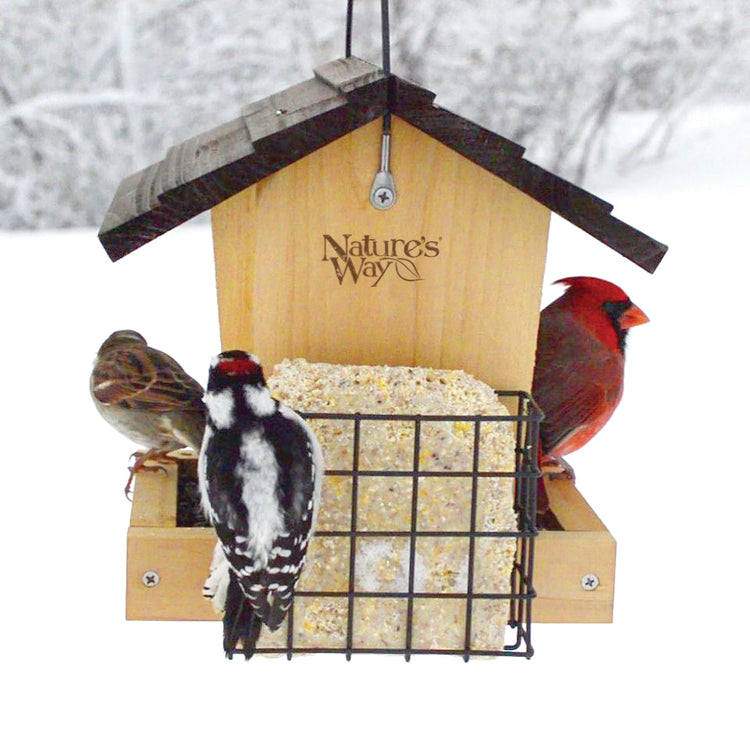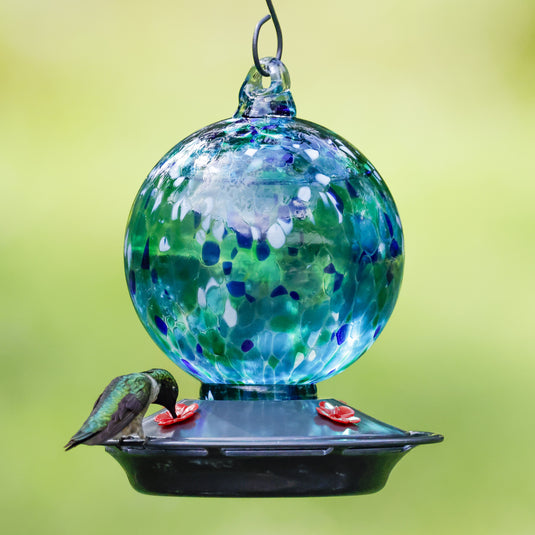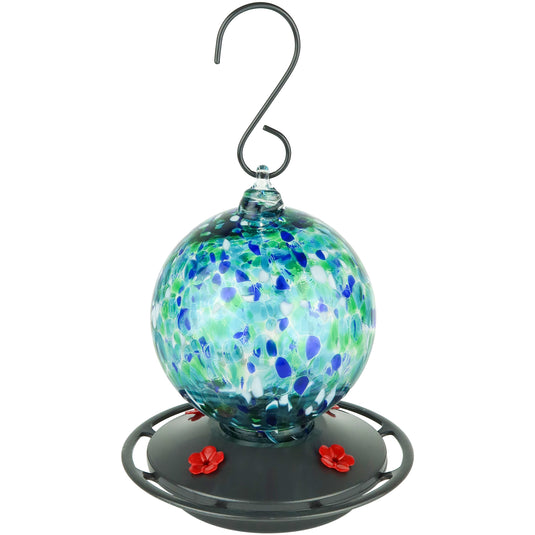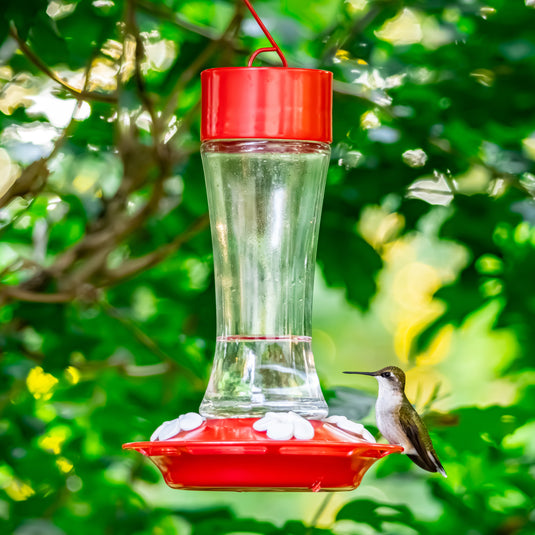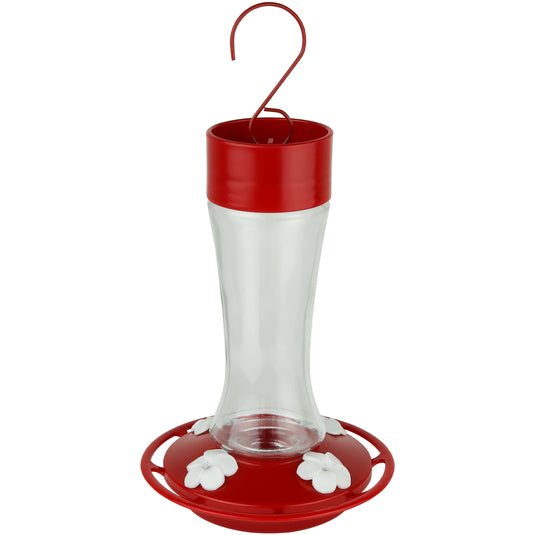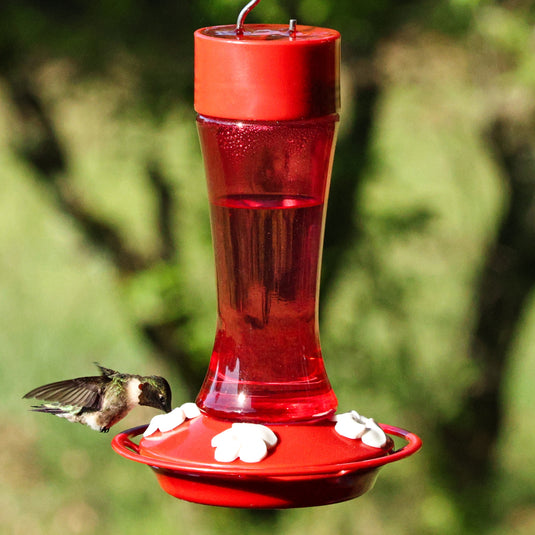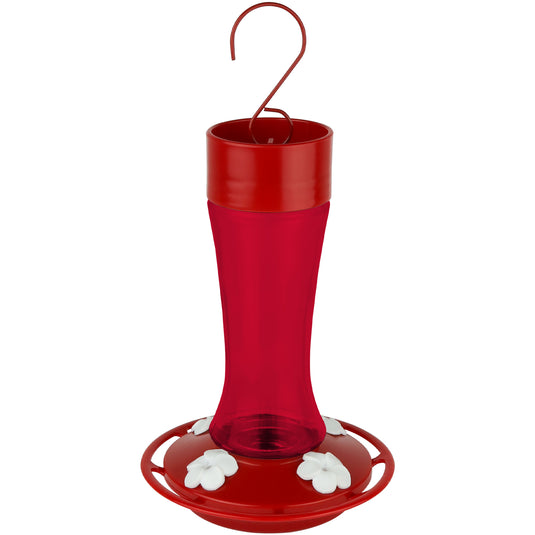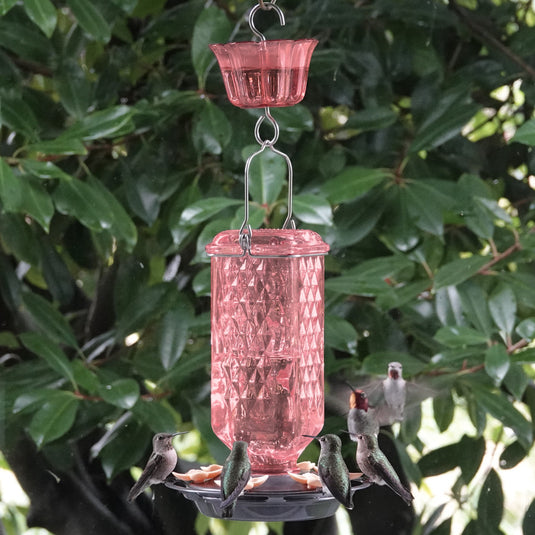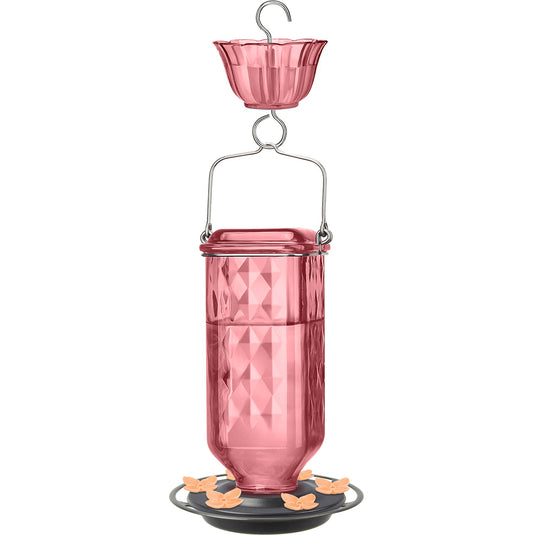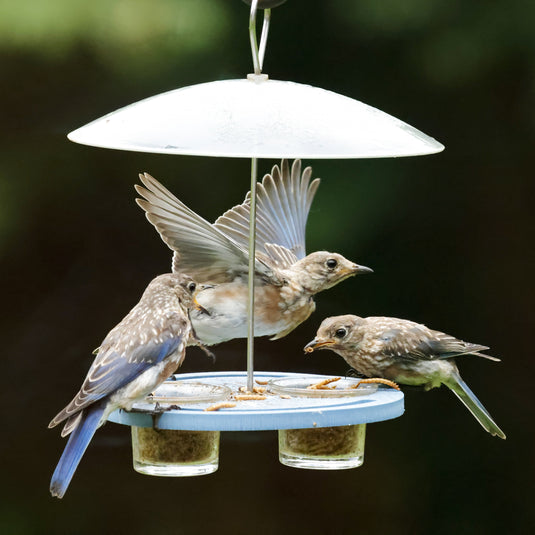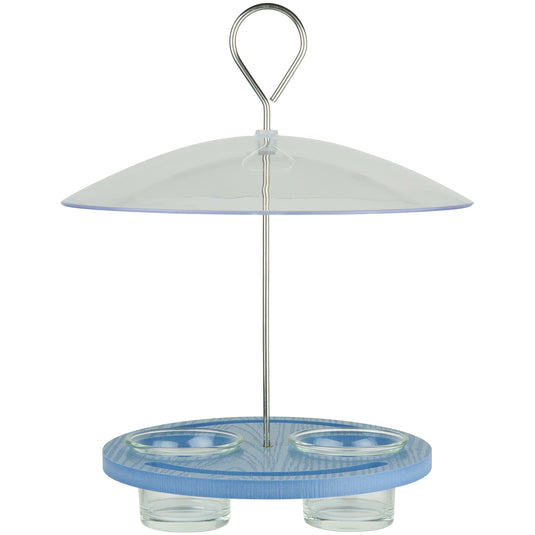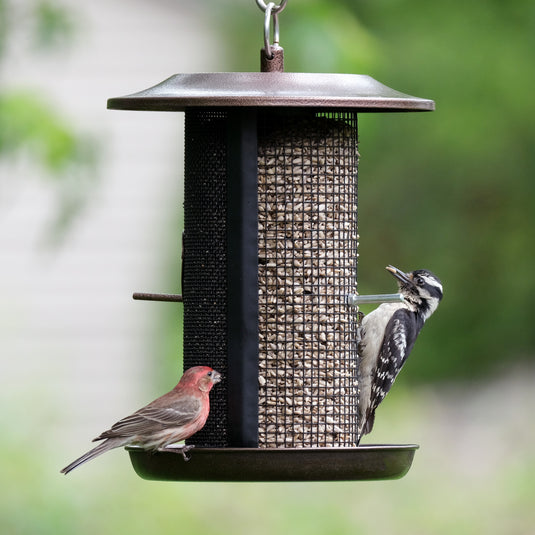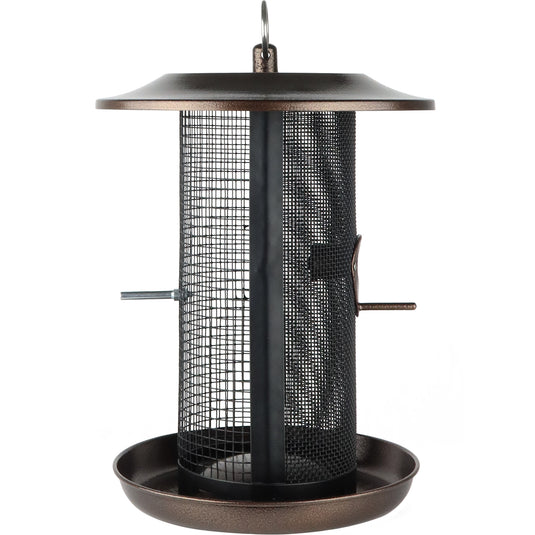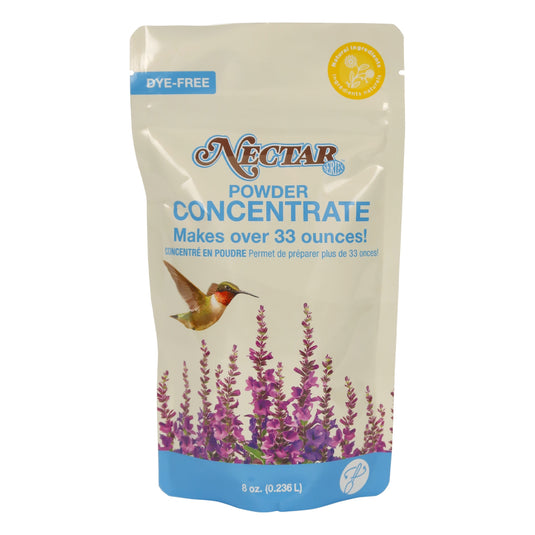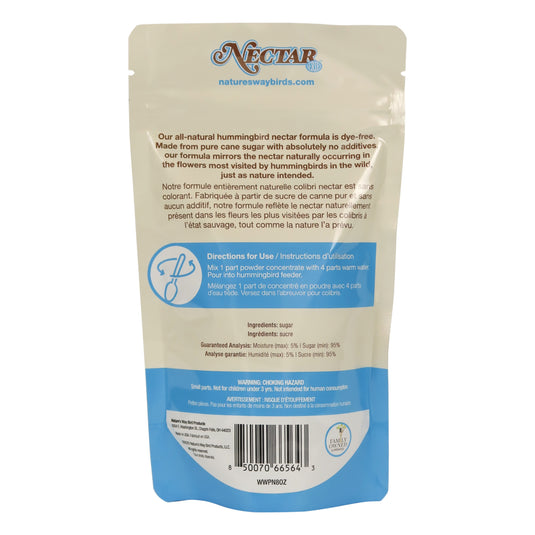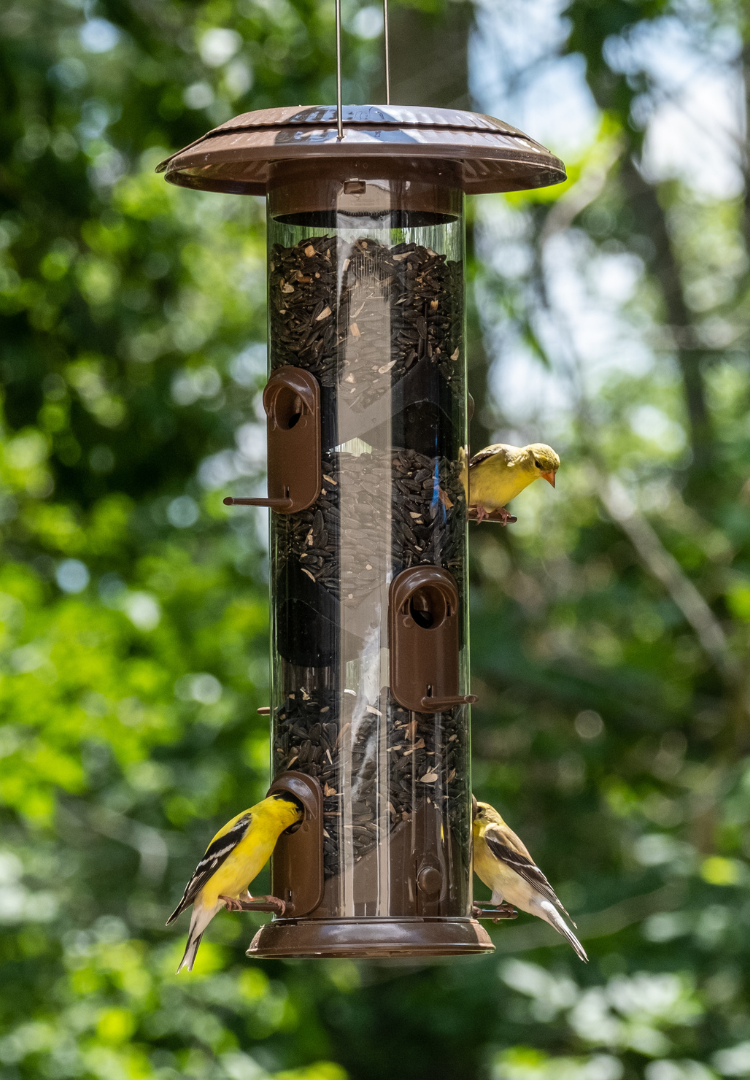With migratory birds departed to warmer regions, it’s a common misconception that there are fewer birds to enjoy in the winter months. On the contrary, winter is the one of the most beneficial seasons to feed wild birds! Since resources like insects, nuts and fruit become scarce, even birds who wouldn’t normally frequent bird feeders may come to your backyard if you offer them food, shelter, and water. Check out our top tips for winter bird feeding and set yourself up for a successful and enjoyable birding season!

Pictured: 3 QT Hopper Feeder w/ 2 Suet Cages
Feeding tips
Best seed and feed types
Suet: Suet is the purest and hardest piece of fat found on an animal. Packed with protein and nutrition, suet is a quick source of heat and energy for many birds including Woodpeckers, Titmice, Chickadees and Nuthatches. Also, many birds that eat insects to round out their diets will eat suet in the winter months to fill the void when the insects they typically feed on are not plentiful.
Black oil sunflower seed: One of the most popular seed types amongst backyard birds is black oil sunflower seed. These large, thick seeds have a high-oil content and are loaded with protein, fiber, calcium, and more nutrient rich contents.
Peanuts: Dry-roasted, unsalted peanuts are a high-energy food enjoyed by a wide variety of birds including Woodpeckers, Titmice, Nuthatches, Chickadees, Jays and more. They are high in both protein and fat, making them a great fuel for birds in winter.
Fresh and dried fruits: When fresh fruits become sparse in the winter, you can offer apple slices, berries, grapes, or even fruit rinds in a platform or suet feeder for the birds to munch on. Dried fruits like cherries, raisins, and cranberries remain high in fiber which is converted into energy. These fresh and dried fruits will attract Chickadees, Jays, Finches, Cardinals, Titmice, but be aware that offering this type of treat may attract unwanted wildlife, including raccoons, squirrels, and opossums. To deter them, try not to overfill your feeders, bring them inside at night, and make sure to keep them clean.
Best bird feeder types
Suet bird feeders: A suet feeder is a must-have for any winter birder! To accommodate larger birds like woodpeckers, some suet feeders are elongated into a tail-prop design, allowing them to balance their body weight by placing their tail against the feeder. Other suet feeders expose the suet at the bottom, making the contents inside less susceptible to incoming weather. These upside-down feeders also help deter nuisance birds like Starlings and Grackles who are most comfortable feeding upright.
Tube bird feeders: A strong and durable tube feeder is a great choice for feeding sunflower or Nyjer seed (using thistle inserts). The long, slim cylinder keeps the seed out of the elements while multiple feeding ports allow for many birds to feed at once. To make refilling easier, choose a high-capacity tube feeder with a wide and funneled opening to minimize the time spent outdoors in the chilly weather!
Hopper bird feeders: A high-capacity hopper bird feeder can hold a lot of seed (up to 6 quarts!) at once, making it a good choice to feed lots of birds with minimal refilling. Some hopper feeders also come with suet cages attached on either side, allowing multiple feed options in one to attract an even wider variety of winter birds.
Squirrel-proof bird feeders: Squirrels are an ever-present pest at bird feeders no matter the time of year, but especially in the winter when other food sources are scarce. A sturdy squirrel-proof feeder can help deter these unwanted feeder visitors by using a variety of mechanisms to deter feeder pests, including built-in roof baffles, weight-sensitive outer tubes and spring-loaded perches.
More feeding tips
Add more bird feeders: To increase bird traffic to your yard, consider increasing the number of bird feeders, as well as feeder styles, to provide the birds with a consistent food source of their liking. Not all bird species eat seeds, so adding feeders that accommodate suet, dried fruit or nuts will cater to a wider variety of birds.
Choose the right location: The location of your bird feeders should make the birds feel safe and at home. Birds are likely to feed more comfortably when near natural cover like trees, shrubs, or other vegetation. This provides shelter for birds to view their feeding area so they can see any predators while waiting for their turn to feed. Remember to keep the feeders roughly 10-12 feet from any tree or obstacle to deter unwanted pests from reaching the seed. To help prevent fatal window collisions, feeders should be hung or mounted closer than 3 feet or farther than 15 feet from a window.
Use a baffle: To protect the seeds and birds from incoming weather, use a baffle when hanging your bird feeder. A baffle can also help deter unwanted pests from accessing your bird feeders.
Keep them clean: Even in the colder winter months, it’s important to clean your bird feeders on a regular basis to prevent the buildup of bacteria that can cause disease. Feeders can sometimes be even busier during the winter months with the influx of migrating birds and as inclement weather makes other natural food sources harder to come by.
Provide water
When freezing temperatures hit, locating fresh water can become difficult for wild birds. Providing a consistent source of clean and fresh water from a bird bath or fountain will keep your backyard birds hydrated in the cold winter months.
Don’t let it freeze: If your water source is stagnant, consider adding a fountain or a heater to keep the water moving. Place it in a location that receives full sun to help prevent the water from freezing too quickly. Keeping your bird bath full will help slow down the freezing process. A shallow bird bath can become frozen very quickly.
Keep it clean: It’s important to keep your water source clean and change the water often to prevent bacteria from forming and spreading amongst the birds.
Set up shelters
While birds and critters have many ways to keep warm in the winter, they still seek protection from storms, wind, and extreme temperatures. To help protect birds in inclement weather, make sure your yard has adequate shelters for birds to take cover or spend the night.
Birdhouses: While birds won’t use the houses to nest during the winter, they will take cover inside a birdhouse or roost box. Birdhouses are traditionally used for nesting and raising young in the spring and summer and are designed with air vents to promote air flow through the house. If you don’t own a roost box, you may choose to add some insulating material to your birdhouse, such as wood chips or straw, to help make the house a little warmer for visiting birds. Just make sure you clean it out in the early spring!
Natural shelters: The best place for birds to take shelter in the winter is in bushes, dense vegetation, or trees. But if your yard is lacking in plants and trees, you can set up some natural shelters using other materials. Have some leftover corn stalks or hay bales from fall decorations? How about your holiday tree? Gather up any natural materials in your yard and place them in a pile for the birds to use.

